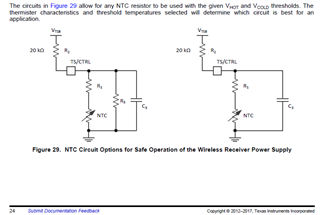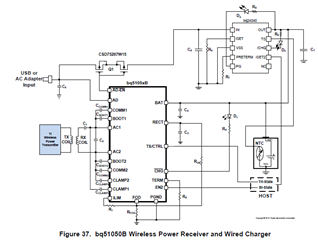Other Parts Discussed in Thread: BQ51051B, CSD75207W15, BQ51003, BQ51013B, BQ25170
Hi!
I am considering the combination of BQ24045 (to AC-adapter) with BQ51051B (Qi-charging) and am uncertain about the proper topology of the battery temperature monitoring circuit (NTC).
Based on BQ51051B DS, p. 24 (Figure 29, topology to the right in the figure, cf. excerpt attached), and the battery temperature requirements, we have chosen a certain 10k NTC with B=3435 (inside the battery). In our configuration, R_1 = 200ohm.
Hence, the battery NTC is currently monitored by the BQ51051B TS/CTRL pin
Now, I wish to add support for AC-adapter charging and am considering the schematics proposal on p.32 (Figure 37) of BQ51051B DS. In this schematics, the BQ24045 TS pin is connected directly to the NTC inside the battery, while the TS/CTRS of the BQ51051B is not connected to the battery NTC, but controlled from the host MCU.
Ideally, with the combination of BQ24045 and BQ51051B, we would like obtain the same temperature charging characteristics, regardless of which charger is used. Further, we would like to to avoid any SW implementation of temperature monitoring.
Is it possible to connect the TS output from both chargers to the battery NTC? If so, which topology would you recommend?
Alternatively, will the BQ51051B continue to monitor the battery temperature even in the case when BQ24045 is carrying out the battery charging? If so, can we count on the AD-EN output from BQ51051B to gate out the input voltage to BQ24045, should the temperature limits of the battery be exceeded? (provided that we use the CSD75207W15 back-back FET or equivalent)
Thanks and kind regards
/Carl Fredrik Leanderson



